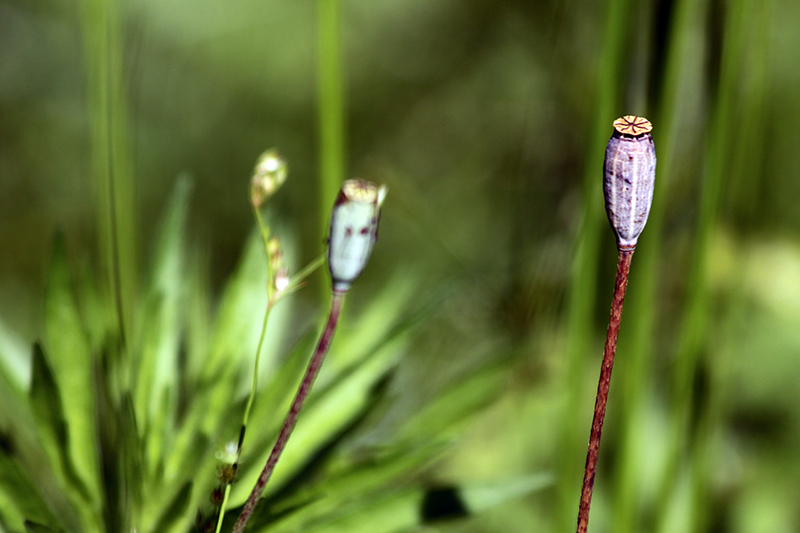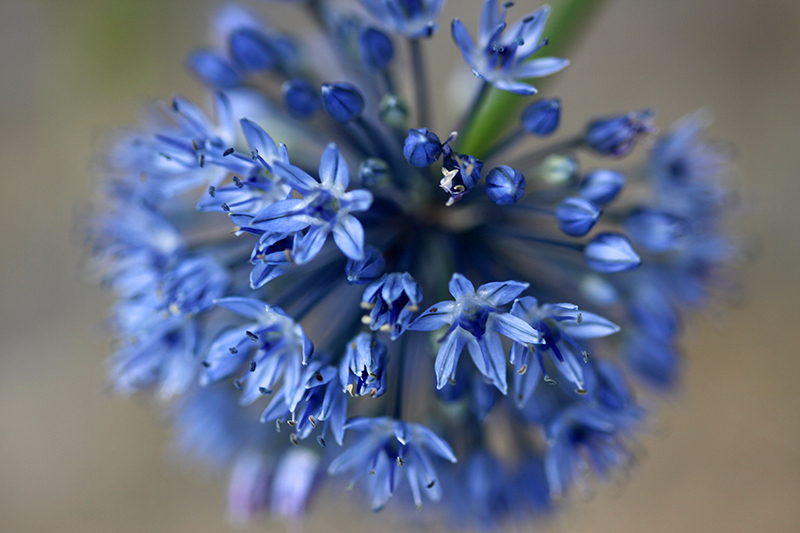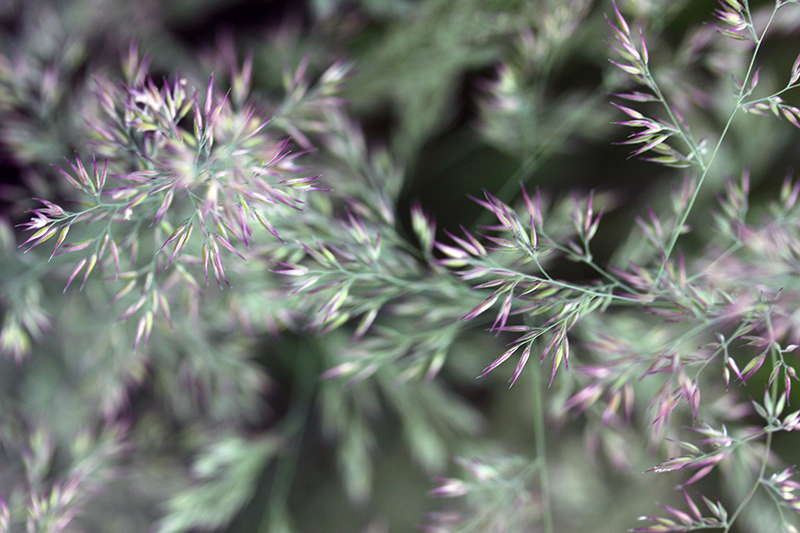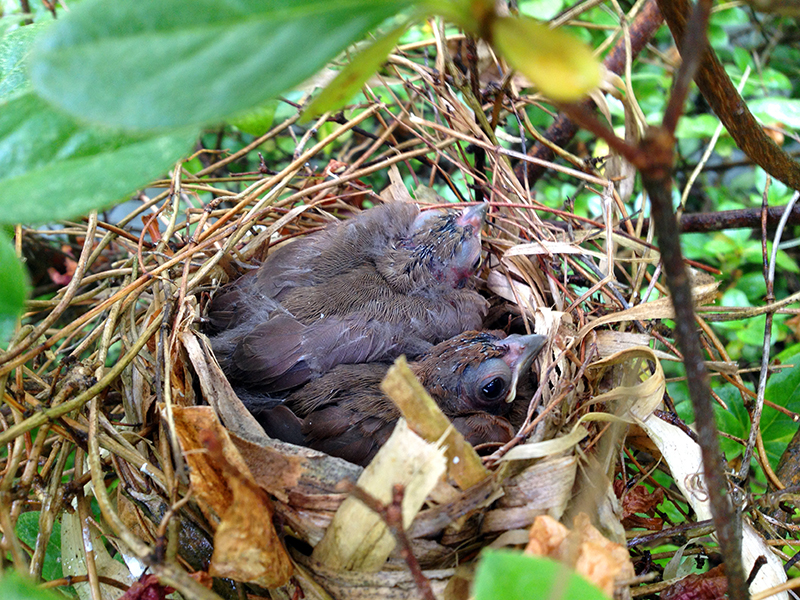June 28th, 2014 §
This is a nymph form of the Wheel Bug (Arilus cristatus), which I found perched on an almost-blooming thistle in my “wildflower meadow.” The nymphs appear in mid-June, and when they molt they will emerge brilliant coral with the characteristic wheel-shaped ridge on the back. About twenty minutes after molting, the Wheel Bug will turn from pink to grey.

Wheel Bugs, which are members of the Assassin Bug family, are incredibly beneficial to have in your garden as they prey on all sorts of pests including members of the dreaded stink bug family (harlequin bugs, squash bugs, brown marmorated stink bugs, etc.), which really decimate my garden. However, you don’t want to get bitten by an Assassin Bug—it is supposedly ten times more painful than a bee sting. So give these guys a wide berth when you find them, but definitely keep them around!
June 27th, 2014 §
The year’s second batch of bluebirds hatched early this week. There were four eggs, and now three hungry babies.



June 26th, 2014 §
This is the first harvest of summer 2014—a few squash and zucchini that managed to outrun the oncoming squash bugs, some hot peppers, basil and other herbs, and five Sun Sugar tomatoes. Tomatoes before the fourth of July—not bad considering our long, cold spring.

The zinnias are just coming on, and I bet tomorrow I will see the first cosmos bloom. It is great to be back in the cutting flower business. From now until frost there will be homegrown bouquets all around my house. 
Such bounty calls for a celebration with fire. As I didn’t do much for the Solstice this past weekend, I fired up the grill to cook a first harvest/Solstice feast as thunder bounced around the mountains. I just got the grill a few weeks ago, a gift from my mom, and it’s been a steep learning curve to understand this entirely new way of cooking. It’s a good challenge, and one I needed as my culinary selfeducation had grown stagnant. It feels wonderful to push myself, to make mistakes, have “eureka” moments and accidental epiphanies, and at the end of it all, if I’m lucky, dinner.

And what a dinner it was. Garlic shrimp, my veg, some corn slathered with butter and seasonings and wrapped back up in its husk to grill. A simple, perfect salsa made with my five pretty gold tomatoes, basil, salt, pepper and olive oil. These squash were on a whole other level from the pallid supermarket varieties I grilled last week. Call me a tree-hugging hippie, but I can taste a difference when I eat something I planted in April as a two-leafed seedling, nurtured and protected, and finally harvested within twenty minutes of consuming. Vegetables taste alive, almost meat-like in their nutrition and vitality. They go straight to my brain.

And, nothing is wasted.
June 25th, 2014 §
Look who bounded in the house last night, keyed up like all get-out, covered forehead to paws in skunk juice, as I was all showered and in my pjs and ready to go to bed? At least he took it like a man and was only shot down his front and not all over. So last night at 10:00 p.m. I was doing emergency bathing in a little puddle of floodlight.

I suppose I shouldn’t complain too much. The last time Tuck was skunked was May 2012, which isn’t too bad for living in the wilderness. At least now I have my act together to run a hot water hose out of the laundry room, so I don’t have to do cleanup in the house.
One word: Technu. It’s that poison ivy, outdoorsman soap that combines with and removes nasty oily stuff. After the last skunking, I’d bought a bottle for just such an emergency, and boy, does it work. I rubbed it into Tuck’s fur and it seemed to instantly neutralize the skunk smell in a way that the dish soap and vinegar I used last time didn’t. I followed up with a regular dish soap wash and this morning he smells pretty decent, all things considered. Interestingly, the Technu wasn’t as effective at removing the smell from Tucker’s invisible fence and nylon collars, which still smell pretty skunky.
There are some recipes for homemade skunk smell remover online, but they use hydrogen peroxide. As the owner of a black dog, I didn’t want to play amateur beauty parlor and end up with a bleached-out pet!
June 24th, 2014 §
All things considered, last winter’s polar vortex left Bonafide Farm relatively unscathed. I lost a few plants, including some huge rosemary bushes, a new lilac, and a handful of perennials. My ‘Pat Austin’ rose died back by half but returned with new canes, only a bit misshapen. But my fig tree was another story entirely.
Figs are considered to be tender trees in this climate, even in non polar vortex winters, and only survive if planted in warm, sheltered locations. Knowing this I planted mine, a cultivar called ‘Celeste,’ on the south side of the big white garage wall, where it would bake in the summer and enjoy wind protection and reflected heat in the winter. 
It seemed to be doing well, and after three or four years in the ground, last year it attained about six feet in height and was really starting to crop. I was pretty happy I got a fig to grow here. This year, however, I waited and waited for signs of life from it. April passed, and May crept on. The bare grey branches showed no sign of budding, and I started to lose hope and began planning to replace my fig.

But then in early June I saw tiny green buds sprouting from the fig’s base. Halleluiah! I held off on cutting back the dead branches until it became clear that the tree was in full rejuvenation mode, coming back from the ground, and all its old wood was dead. Then out came the saw and pruners and I dismantled several years of growth to make way for the new sprouts.
As the heat’s turned on the fig has taken off, lush and thick with growth that’s now about two feet tall. It will probably be another three years until it bears fruit again, but I am just so happy to have not lost the tree that I can wait.
And speaking of waiting, let me tell you a story about a fig that waited fifteen years to find a home at Bonafide Farm.
I went to college in Tucson, Arizona, and when I was either nineteen or twenty I moved into an old stucco duplex south of campus. I was told that the home was built around 1900 by German immigrants who were hired to build the railroad through Tucson. Each German family brought cuttings of their fig trees from back home and planted them in their new country. I had one such fig tree in my backyard, and it took up most of the lot. It was huge, probably 15 feet tall and wider than that, thick with gnarly grey branches that bore copious green figs. Here’s the only photo I could find, which I scanned, looking at the back of the house through the fig branches, which are just leafing out:

Knowing nothing about tree propagation, I took cuttings from this fig and stuck them in coffee cans of soil on my porch. Amazingly, they rooted. I got two small trees growing, which I potted up into successively larger pots…and then proceeded to cart around the country for the next fifteen years. The trees went with me to San Diego, and while I was living in DC they lived at my parents’ house, where my mom made sure they didn’t die. Four years ago the trees came to live here, but I still didn’t plant them in the ground because I was afraid they wouldn’t be able to take the winter and would die. So they stayed in their pots, where I had essentially turned them into bonsai by limiting their growth, and they produced a few pale figs in the summer. Each winter I stored them in the wellhouse.
Well, this spring when I pulled them out they weren’t looking so hot, which I understood as it got cold enough to freeze the pipes in the wellhouse last winter. The figs’ branches were dry and shriveled, and I couldn’t sense a heartbeat from either tree. Still, I stuck them in the sun and watered them, and waited, growing more forlorn as the weeks passed with no signs of life. I was very sad to lose trees that had such history, and mad at myself for not planting them in the ground earlier (which I am learning is a pattern of mine, and one to be changed), even though there’s no guarantee they would have fared better there.
But then last week I looked at one of the trees and saw the palest shade of green on one of the branches. Could it be? Was it still alive?

Wasting no time—this time—I dug a hole right next to my other fig (for botanical companionship and moral support), and planted my Tucson fig. I watered it in well, and put up a chicken wire fence to protect it from the dog. Within three days the green bud burst into a tiny leaf, and other green buds appeared. Now, after just a week in the ground, the fig is leafing out.

And there’s the story of the redemption of the figs, and how new old trees grow at Bonafide Farm.

June 17th, 2014 §
This gorgeous cuckoo wasp (Parnopes chrysoprasinus…I think) flew in the front door last night, along with myriad tiny gnats that managed to set off the fire alarm outside of my bedroom in the middle of the night, turning what was already a miserably hot and humid sleep into one spiked with gallons of adrenaline. Ahhh…summer.


June 14th, 2014 §
Meadows are hot right now, with horticulturalists’ renewed focus on habitat preservation/creation and the rise of the “new perennial” gardening movement that showcases native and “wild-looking” plants in naturalistic compositions. Everyone loves a meadow—or at least the image of them as presented in aspirational garden porn—billowing fields of lively grasses punctuated with bright yellow, pink and white blooms that persist all summer long. 
There are several ways to achieve the cultivated meadow look, and the most commonly accepted, and perhaps effective, method involves several rounds of herbicide spray that kill all existing plants back to bare dirt, a process that takes about a year in order to catch each wave of germination. The idea is to create a blank slate so that you may then, ideally in the fall, sow a mix of wildflower seeds that’s usually composed of annuals, to give you quick, first-year color, and perennials, which will take longer to get going but persist and multiply through the years. Without leveling the playing field with herbicide, the desired wildflower seeds most likely wouldn’t be able to germinate and out-compete the existing vegetation.
All this is fine, and I’ve seen some lovely meadows created this way. But the idea of mass herbicide spray doesn’t sit well with me, nor does watching vast swaths of ground turn brown and shrivel, taking with it the native plants in all their diversity only to be replaced with a select blend of imports. As much as I would love to try creating a wildflower meadow, and still may, I haven’t yet been able to reconcile the steps I’d have to take to get there.

But as I was mulling this gardener’s quandary, a wildflower meadow was quietly forming right in my own yard with almost no help from me. It happened in the transitional zone between the forest and my mowed field, on a patch of ground that had been thickly colonized by invasive alanthus trees, honeysuckle, and brambles. This area was cleared back to bare dirt two winters ago, and I basically just left it alone.

Last year I noticed tons of mullein plants sprouting in the bare dirt. Mullein are the pioneers of the plant world—they are among the first plants to recolonize disturbed ground. They are biennials, and in their first year form a rosette of soft, fuzzy grey-green leaves. The second year the plants shoot tall yellow flower stalks high into the sky. Mullein has a long and respected heritage in herbal medicine, and is commonly used to treat disorders of the respiratory system. If you believe in the doctrine of signatures, the leaves of mullein are lung-shaped, which indicates that they are beneficial to that part of the body.
I think mullein are incredibly beautiful, and so I refrained from mowing them last year in order to see them bloom this year. Well, in not mowing this patch of ground, I unintentionally created what has turned out to be a fascinating wildflower meadow—no herbicide needed. In addition to purple clover, wild strawberries, and countless other plants, here are just a few of the flowers I’ve identified in my meadow:

Dianthus armeria, or Deptford Pink, a relative of Sweet William

Achillea millefolium, common yarrow

Some kind of very pretty, low-growing grass that reminds me of the “fiber optic grass” sold in nurseries. Any ideas what it is?

Papaver aculeatum (I think), orange poppy, gone to seed

Triodanis perfoliata, Venus Looking Glass

Wild onion, gone to seed

Parthenocissus quinquefolia, Virginia creeper, with Erigeron strigosus, Prairie Fleabane in the background

I look forward to watching this meadow progress through the summer, but in the meantime I find it so striking that the former hayfield, above, which I bush hog every now and then, is so much less botanically diverse than the new meadow, below, which sits just a few feet away. I am not sure if this is because the hayfield was created (how are hayfields created, anyway?) once upon a time to be primarily grasses, but I would have thought that by now it would have reverted to a more wild state. Perhaps the grass cover is too thick to allow other plants to germinate? Botanical succession—how plants reclaim and populate land, which come first, and how they create ideal conditions for each successive wave of new plants—fascinates me, and I am glad to have these uncultivated meadows that provide a wonderful laboratory to watch and learn from this process.

June 13th, 2014 §
The early June garden is shaping up nicely, and I am finally starting to see the effects of last year’s work as new additions bloom for the first time and older plants mature into proper specimens.

Allium caeruleum, a true blue color that’s hard to find among flowers of all kinds. I added a few to the garden last fall and they have bloomed with weak necks, which may be that they need time to beef up or they’re not happy with their locations. I hope it’s the former, as the color is awesome.

Deep red Asiatic lily, a big-box bag purchase that in four years has formed healthy, trouble-free (thus far), huge colonies in the garden.

Pink gaura

Ornamental feather reed grass, Calamagrostis acutiflora ‘Karl Foerster’ just heading up. Another standby that along with the lilies gives good height to the back of the June garden.

Geranium ‘Brookside’ bloom in front of Festuca glauca ‘Elijah Blue.’ I am really excited about these new hardy geraniums, or cranesbill, which I just put in all along the rock border of the garden. The idea is that they will spread and colonize these edges, and, I hope, keep the chickens from scratching all the mulch out of the garden into the yard. They’re gorgeous little plants, with blooms that are in life a bit bluer than in this picture.
My blue fescue has finally this year (I think it’s their third) matured into nice big plants that look like landscaping instead of errant pasture grass. I love how their color is almost an exact match for my porch floor.

Iris ensata ‘Caprician Butterfly’. This Japanese iris goes through it’s bloom cycle so fast it’s hardly worth it. It spends one day blooming like this, then the next day the top petals drop down creating a flattened, donut-like bloom, and the next day the bloom is shriveled and brown. The bloom shape is not a look I love—I much prefer the upright flowers of the German and Siberian iris, but this plant was an experiment (aren’t they all!?) in growing irises that aren’t as susceptible to iris leaf spot as the German irises I removed from the garden.
June 9th, 2014 §

I found these little guys high in the big azaleas by the garage. It’s been a challenge to get a good photo of them—when disturbed they tuck their heads into the nest and flatten their bodies. Here’s their nest ten days earlier, for those of you who are working on your nest/egg i.d. skills:

This is the first cardinal nest that I’ve found, and it’s right in my yard. As everyone’s sounding alarms about the decline of our native songbird populations, because of habitat loss and home and agricultural pesticide and herbicide use, I am very happy to be fighting back by maintaining a property that supports birds’ needs well enough to encourage them to breed here. To some people a bird’s nest is just a bird’s nest, but to me it’s a sign that I must be doing something right on this tiny scrap of land I’ve chosen to take care of.
June 8th, 2014 §
The two little pullets that hatched in March are twelve weeks old today. I know it’s poor judgement on my part, especially given a day-time fox sighting at the back of the property last week, but I have grown rather fond of them. They are incredibly cute, and are more tame than any of the other chickens I have raised. They are still small enough that I can easily hold both in one hand. They think nothing of half-flying, half-running all the way across the unknown lawn toward me when they feel threatened. Adorable.

A couple of weeks ago, when I finally got their injured broody mother reintegrated into the main flock, I moved the chicks from their broody coop in the garage into a big dog crate in the main coop, where they have their own food and water. They are getting used to being with the main flock while still being protected from attacks. I have also started letting them free range a little, turning them loose in the front garden while I am outside. They’ve met the larger birds during their rambles, and of course were chased and pecked back (but not injured) into hiding places in the bushes.

They discovered dust bathing the other day. The hilarious thing was that despite having access to a whole garden of soft soil, they chose to bathe right on top of one another, kicking each other in the heads as they burrowed into this new experience.

It’s neat to watch the chicks explore their world. They are in many ways like kids and baby animals everywhere—a mixture of boldness and trepidation.

Against my better judgement of growing too attached to animals that could at any moment meet their ends in a number of horrible ways, I have named them Buttercup and Clover.









































